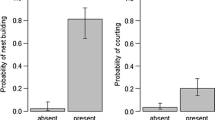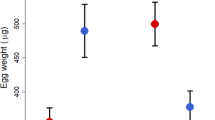Abstract
In group-living animals, dominants may suppress subordinate reproduction directly and indirectly, thereby skewing reproduction in their favour. In this study, we show experimentally that this ability (‘power’) is influenced by resource distribution and the body size difference between unrelated dominants and subordinates in the cichlid Neolamprologus pulcher. Reproduction was strongly skewed towards the dominant female, due to these females producing more and larger clutches and those clutches surviving egg eating better than those of subordinate females, but was not so when subordinates defended a patch. If breeding shelters were provided in two patches, subordinate females were more likely to exclusively defend a patch against the dominant female and breed, compared to when the same breeding resource was provided in one patch. Relatively large subordinate females were more likely to defend a patch and reproduce. Females also directly interfered with each other’s reproduction by eating the competitors’ eggs, at which dominants were more successful. Although dominant females benefited from subordinate females due to alloparental care and an increase in egg mass, they also showed costs due to reduced growth in the presence of subordinates. The results support the view that the dominant’s power to control subordinate reproduction determines reproductive partitioning, in agreement with the predictions from tug-of-war models of reproductive skew.





Similar content being viewed by others
References
Adkins-Regan E (2005) Hormones and animal social behavior. Princeton University Press, Princeton
Awata S, Heg D, Munehara H, Kohda M (2006) Testis size depends on social status and the presence of male helpers in the cooperatively breeding cichlid Julidochromis ornatus. Behav Ecol 17:372–379
Balshine-Earn S, Neat FC, Reid H, Taborsky M (1998) Paying to stay or paying to breed? Field evidence for direct benefits of helping behavior in a cooperatively breeding fish. Behav Ecol 9:432–438
Balshine S, Leach B, Neat F, Reid H, Taborsky M, Werner N (2001) Correlates of group size in a cooperatively breeding cichlid fish (Neolamprologus pulcher). Behav Ecol Sociobiol 50:134–140
Beekman M, Komdeur J, Ratnieks FLW (2003) Reproductive conflicts in social animals: who has power? Trends Ecol Evol 18:277–282
Bergmüller R, Heg D, Taborsky M (2005) Helpers in a cooperatively breeding cichlid stay and pay or disperse and breed, depending on ecological constraints. Proc R Soc Lond B 272:325–331
Brouwer L, Heg D, Taborsky M (2005) Experimental evidence for helper effects in a cooperatively breeding cichlid. Behav Ecol 16:667–673
Crawley MJ (2002) Statistical computing. An introduction to data analysis using S-plus. Wiley, Chichester
Dierkes P, Heg D, Taborsky M, Skubic E, Achmann R (2005) Genetic relatedness in groups is sex-specific and declines with age of helpers in a cooperatively breeding cichlid. Ecol Lett 8:968–975
Dierkes P, Taborsky M, Achmann R (2008) Multiple paternity in the cooperatively breeding fish Neolamprologus pulcher. Behav Ecol Sociobiol (in press)
Faulkes CG, Bennett NC (2001) Family values: group dynamics and social control of reproduction in African mole-rats. Trends Ecol Evol 16:184–190
Hamilton IM (2004) A commitment model of reproductive inhibition in cooperatively breeding groups. Behav Ecol 15:585–591
Hamilton IM, Heg D, Bender N (2005) Size differences within a dominance hierarchy influence conflict and help in a cooperatively breeding cichlid. Behaviour 142:1591–1613
Heg D, van Treuren R (1998) Female-female cooperation in polygynous oystercatchers. Nature 391:687–691
Heg D, Bachar Z, Brouwer L, Taborsky M (2004a) Predation risk is an ecological constraint for helper dispersal in a cooperatively breeding cichlid. Proc R Soc Lond B 271:2367–2374
Heg D, Bender N, Hamilton I (2004b) Strategic growth decisions in helper cichlids. Proc R Soc Lond B 271:S505–S508
Heg D, Bachar Z, Taborsky M (2005) Cooperative breeding and group structure in the Lake Tanganyika cichlid Neolamprologus savoryi. Ethology 111:1017–1043
Heg D, Bergmüller R, Bonfils D, Otti O, Bachar Z, Burri R, Heckel G, Taborsky M (2006a) Cichlids do not adjust reproductive skew to the availability of independent breeding options. Behav Ecol 17:419–429
Heg D, Heyl S, Rasa OAE, Peschke K (2006b) Reproductive skew and communal breeding in the subsocial beetle Parastizopus armaticeps. Anim Behav 71:427–437
Heg D, Heg-Bachar Z, Brouwer L, Taborsky M (2008) Experimentally induced helper dispersal in colonially breeding cooperative cichlids. Environ Biol Fishes (in press)
Johnstone RA (2000) Models of reproductive skew: a review and synthesis. Ethology 106:5–26
Langer P, Hogendoorn K, Keller L (2004) Tug-of-war over reproduction in a social bee. Nature 428:844–847
Limberger D (1983) Pairs and harems in a cichlid fish, Lamprologus brichardi. Z Tierpsychol 62:115–144
Nonacs P (2000) Measuring and using skew in the study of social behavior and evolution. Am Nat 156:577–589
Ratnieks FLW, Wenseleers T (2005) Policing insect societies. Science 307:54–56
Reeve HK, Keller L (2001) Tests of reproductive-skew models in social insects. Ann Rev Entomol 46:347–385
Reeve HK, Emlen ST, Keller L (1998) Reproductive sharing in animal societies: reproductive incentives or incomplete control by dominant breeders? Behav Ecol 9:267–278
Sandell MI, Smith HG (1996) Already mated females constrain male mating success in the European starling. Proc R Soc Lond B 263:743–747
Schradin C, Lamprecht J (2000) Female-biased immigration and male peace-keeping in groups of the shell-dwelling cichlid fish Neolamprologus multifasciatus. Behav Ecol Sociobiol 48:236–242
Scott MP (1997) Reproductive dominance and differential ovicide in the communally breeding burying beetle Nicrophorus tomentosus. Behav Ecol Sociobiol 40:313–320
Taborsky M (1984) Broodcare helpers in the cichlid fish Lamprologus brichardi: their costs and benefits. Anim Behav 32:1236–1252
Taborsky M, Limberger D (1981) Helpers in fish. Behav Ecol Sociobiol 8:143–145
Taborsky B, Skubic E, Bruintjes R (2007) Mothers adjust egg size to helper number in a cooperatively breeding cichlid. Behav Ecol 18:652–657
Acknowledgement
We thank the Hasli members and particularly Nicole Basieux and Renate Zindel for discussions and comments, Rolf Eggler and Peter Stettler for technical assistance and Roger Schürch, Rick Bruintjes and the anonymous referees for comments on the manuscript. This work was funded by the Swiss National Science Foundation grants SNSF 3100A-108473 and 3100A0-105626.
Author information
Authors and Affiliations
Corresponding author
Additional information
Communicated by K. Lindström
Appendix
Rights and permissions
About this article
Cite this article
Heg, D., Hamilton, I.M. Tug-of-war over reproduction in a cooperatively breeding cichlid. Behav Ecol Sociobiol 62, 1249–1257 (2008). https://doi.org/10.1007/s00265-008-0553-0
Received:
Revised:
Accepted:
Published:
Issue Date:
DOI: https://doi.org/10.1007/s00265-008-0553-0




